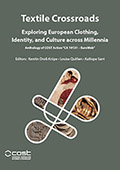Center, Textile Research

Textile Crossroads: Exploring European Clothing, Identity, and Culture across Millennia
Date of this Version
2024
Document Type
Article
Citation
In Textile Crossroads: Exploring European Clothing, Identity, and Culture across Millennia. Anthology of COST Action “CA 19131 – EuroWeb”. Kerstin Droß-Krüpe, Louise Quillien, & Kalliope Sarri, Editors. Zea Books, Lincoln, Nebraska, 2024. DOI: 10.32873/unl.dc.zea.1812
Abstract
Since ancient times, garments served a wide range of purposes: Either functional, providing protection by covering the body, or symbolic, as an element of non-verbal communication and marker of identity. In particular, this stimulates the development of specific characteristics in shape, decoration, or material composition, which generate distinctions among garments, as acknowledged by Roman jurists too.
These distinctions are determined by various factors. One important factor is the social meaning of clothing: There are garments for public life, garments expressing rank, garments suited for special professions, or garments intended for sacred/priestly rites reflecting particular religious symbols. And, of course, clothes that differ between men and women or stages of life. Social meaning subdivides clothing within a society, with legal implications.
Another factor is “fashion”; tastes that change over time, and that clothing adapts to. New norms, socioeconomic conditions, innovative techniques, and foreign influences introduce changes in fashion and transitions in clothing. Fashion subdivides clothing on a chronological or regional level.
Looking backwards in history, changes to clothing are difficult to detect and to date. It is even more challenging to trace the factors causing these changes. This article will present four case studies of clothing in transition: From Prehistory, the Roman Age, the Early Christian Era, and the Early Byzantine Period. Across these four periods, it can be observed that both similar and dissimilar factors shaped clothing transitions. The sources analyzed are written evidence, Roman legal sources, iconographic sources, and material finds.
Included in
Ancient History, Greek and Roman through Late Antiquity Commons, Archaeological Anthropology Commons, Classical Archaeology and Art History Commons, Classical Literature and Philology Commons, Eastern European Studies Commons, European History Commons, European Languages and Societies Commons, Fiber, Textile, and Weaving Arts Commons, History of Science, Technology, and Medicine Commons, Human Geography Commons, Museum Studies Commons, Place and Environment Commons, Social and Cultural Anthropology Commons, Women's Studies Commons


Comments
Copyright © 2024 by the authors.